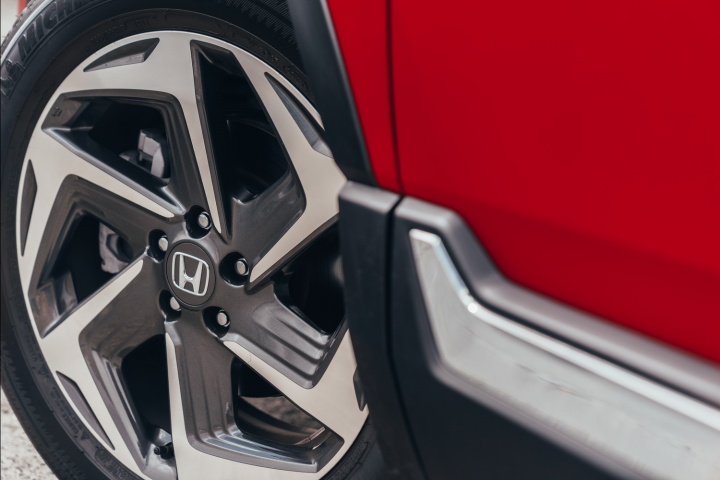Comfortable, refined, roomy, beautifully-built and surprisingly economical: the brave new world of no-diesel SUVs gets off to a good start with the fifth-generation Honda CR-V.
In the metal
To be fair, you're probably going to have to tell most people that your new Honda CR-V is just that. The trained eye will spot the new grille, the lights, the bigger, more clamshell-like bonnet and the more sculpted sides, but to the majority, the overall silhouette and shape are the same. Still, given that Honda often claims that the CR-V is the world's best-selling SUV, and that it makes up as much as 24 per cent of Honda's sales (depending on the market), you can hardly blame it for playing for safety with the CR-V's look. Actually, it's quite handsome - looking especially nice in the optional 'Premium Crystal Red' or 'Premium Agate Brown' paint finishes.
The cabin draws heavily on the Honda Civic, which is both good and bad. The good is that it's really well put together (hey, it's a Honda after all) and that Honda has worked hard on making the materials look and feel a little more 'premium' than what you'd find in the hatchback. The downside is that the main digital instruments look cheap and have a deeply confusing menu for the trip computer, while of the central Honda Connect touchscreen, the best that we can say is that at least it has Apple CarPlay and Android Auto, so you don't have to use the dreadful standard software.
The best thing about the CR-V, though, as it always has been, is its sheer practicality. It's always been one of the roomiest of mid-size SUVs, and that's been expanded upon with this version by a 30mm stretch in the wheelbase (while keeping the same overall length as the outgoing version) and that means that for the first time, Honda can offer the option of seven seats.
The folding third row is a simple affair - no electric adjustment here, you just hoick them into place by pulling a strap, but it's easily done, and you can manage it with one hand. The centre row of seats slides back and forth by 150mm, so you can beg and borrow extra legroom, depending on who's sitting where. In the fully back position, there's club-class stretching room for back seat passengers, and there's almost no transmission hump (despite the all-wheel-drive system) so there's enough space for three adults sitting abeam. The third row is, of course, more designed for kids, but adults can fit back there if they must.
The simpler five-seat version makes do with a fixed rear bench (although it does of course fold flat) and has a very decent 561-litre boot. Official figures for the seven-seat version's boot volume aren't available yet.
In the front of the cabin, aside from some very comfortable seats, the CR-V is just as practical. Honda has moved the door speakers for the stereo system up a little to allow for bigger storage bins, while the centre console has a moving flap that allows you to access extra stowage space - enough to fit in a laptop and a medium-sized bag if you need to.
Driving it
There will doubtless be those who approach the new petrol-only CR-V with a little nervousness. After all, we've become so used to the easy frugality of a good diesel engine that stepping back to petrol seems like it could be a one-way ticket to penury, not least with petrol prices being what they are.
Thankfully, the 1.5 VTEC Turbo four-cylinder engine proves capable of being very economical, much more so than we were expecting. It comes in two power outputs - 173hp for the version with the six-speed manual gearbox, or a more powerful 193hp version for the CVT automatic model. Given that the manual has a slightly long, ponderous action, it's the CVT that seems the nicest to drive. I know that sounds like heresy, but Honda claims that it has worked on making the CVT feel more like a conventional automatic in operation, and that does seem to be the case. Only once or twice on our test drive did we find that it allowed the engine to rev long and high, and the electronics seem constantly on watch to nudge it into a higher 'gear' as you accelerate. It's the most agreeable CVT we've yet driven, actually.
It also seems to make the CR-V more economical in the real world. According to Honda's official figures, an all-wheel-drive 1.5 CR-V, with the CVT, should average 7.1 litres on the combined economy cycle. At the end of a 120km test drive, though, driving through towns, villages, on main roads and up and down the foothills of the Austrian Alps, we managed to squeeze 6.8 litres per 100km, or 41mpg from our test car. And most of that time, that wasn't even using Honda's 'Eco' mode button, which dampens down throttle response and tries to help you achieve superior economy. Something tells us that we're going to miss diesel less than we thought...
In terms of handling, the CR-V is really all about comfort. Honda has jacked up the ride height by around 30mm, and the longer travel front struts and multi-link rear do a good job of soaking up the bumps (although Austrian roads are smooth, by and large, so we'll have to see how well it does with awful Irish tarmac). The corollary of that is body lean, which is mostly well contained, but which occasionally allows the CR-V to lurch if you twirl the steering wheel a little too enthusiastically. You probably won't do that, much, though, as the steering feel is very mushy and while the wheel is well-weighted, the overall sensation is a rubbery one.
The all-wheel-drive system can now send as much as 60 per cent of the engine's power to the rear wheels, and do so faster than before. There's no torque vectoring, but there is a yaw sensor that can help by sending more power to the rear wheels to help balance the car, even without any slippage being detected. Honda also says that the CR-V's Agile Handling Assistant (which uses the stability control to try and make the CR-V feel more agile) should turn it into a handling champ, but the fact is that the CR-V is much better when you sit back and relax and just cruise along. Do that, and it feels pretty nice, really, but you won't ever drive one for the entertainment factor.
It should be very safe, though. All models will come with the Honda Sensing pack, which includes radar cruise control (improved to make it better at dealing with traffic cutting in front of you), lane departure warning and correction, autonomous emergency braking, forward collision alert and traffic sign recognition. There's also an 'Advanced Compatibility Engineering' body structure, which is said to be better at spreading out the loads of a crash across the chassis. Meanwhile, the windscreen pillars have been moved back and thinned down a little to make it easier to see out, which should help you avoid any problems in the first place.
What you get for your money
No rating yet as we're still waiting for Irish prices and specs, but prices should probably go up by between 5-10 per cent, which should mean a floor price of around €34,000. Extra standard equipment should include Honda Sensing and an active noise cancelling system (which works rather like a pair of fancy headphones) that helps to make the cabin very pleasantly quiet. Higher-spec models will get a panoramic glass roof and leather trim for the seats.
Summary
The new Honda CR-V continues to be good at doing what the old one did - it's very spacious, very comfortable, nice (if not exceptional) to drive and feels sufficiently well-made to survive a tactical nuclear strike. The best bit, though, is that by switching away from diesel, you're not really sacrificing much in terms of real-world fuel economy.







































